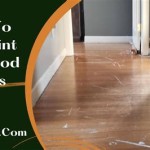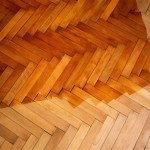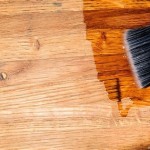The Enduring Appeal of Wood Floors With White Cabinets
The combination of wood floors with white cabinets represents a classic and versatile design choice that has remained popular across diverse architectural styles and interior design trends. This pairing offers a balanced aesthetic, blending the warmth and natural character of wood with the clean and bright appearance of white cabinetry. The adaptability of this combination lends itself to both traditional and contemporary settings, allowing for considerable personalization through the selection of specific wood species, stain colors, cabinet styles, and hardware finishes.
The enduring appeal stems from its ability to create a space that feels simultaneously inviting and sophisticated. White cabinets inherently brighten a room, reflecting natural light and creating an illusion of spaciousness. When paired with the organic textures and varied tones of wood flooring, the overall effect is one of warmth and visual interest, preventing the space from feeling sterile or overly clinical. The interplay between these two elements fosters a balanced atmosphere that resonates with a wide range of preferences.
The successful implementation of this design scheme relies on careful consideration of several factors, including the specific type of wood used for the flooring, the shade and finish of the white cabinets, and the overall style of the space. Attention to detail in these areas will ensure a cohesive and harmonious result.
Key Considerations When Combining Wood Floors and White Cabinets
Several critical factors should be considered when designing a space using wood floors and white cabinets. These considerations range from the practical, such as durability and maintenance, to the aesthetic, such as color palettes and visual balance. Addressing these aspects thoroughly will ensure a successful and satisfying outcome.
Wood Species and Color: The choice of wood species for the flooring is paramount. Different wood types possess distinct grain patterns, hardness ratings, and inherent colors. For instance, oak is a popular choice due to its durability and readily available nature, while maple offers a smoother grain and lighter tone. Hardwood species like hickory and walnut boast greater color variation and distinct grain patterns, adding character and visual interest to the floor. The color of the wood flooring significantly influences the overall aesthetic. Light-toned woods, such as white oak or maple with a clear finish, create a bright and airy feel, complementing the lightness of the white cabinets. Conversely, dark-stained woods, such as walnut or mahogany, provide a dramatic contrast, grounding the space and adding a sense of formality. The specific color chosen should harmonize with the overall design intent and the amount of natural light available in the room.
Cabinet Style and Finish: The style of the white cabinets should align with the architectural style of the house and the desired aesthetic. Shaker-style cabinets, with their clean lines and simple design, are a versatile choice that complements both traditional and contemporary settings. Raised-panel cabinets, on the other hand, evoke a more traditional and formal feel. Flat-panel cabinets offer a sleek and modern aesthetic. The sheen of the white cabinet finish also plays a crucial role. Matte finishes offer a softer, more subdued look, while glossy finishes reflect more light and create a more dramatic effect. The choice of finish should consider the amount of natural light in the room and the desired level of maintenance. Glossy finishes, while visually striking, tend to show fingerprints and smudges more readily than matte finishes.
Hardware and Accents: The hardware selected for the white cabinets acts as jewelry for the space, adding personality and visual interest. Options range from classic knobs and pulls in brushed nickel or antique brass to more contemporary designs in stainless steel or black. The finish of the hardware should complement the overall color palette and style of the space. Similarly, the choice of backsplash material and countertop surface can significantly impact the overall aesthetic. A light-colored backsplash, such as subway tile or marble, reinforces the brightness of the white cabinets, while a darker backsplash provides contrast and visual interest. Countertops in materials like granite, quartz, or butcher block offer a variety of textures and colors that can be coordinated with the wood flooring and cabinets.
Creating Visual Harmony and Balance
Achieving a visually harmonious and balanced space with wood floors and white cabinets involves careful attention to color palettes, textural contrasts, and the overall proportions of the room. The goal is to create a cohesive design that feels both inviting and aesthetically pleasing.
Color Palette and Undertones: While the combination of wood and white is inherently versatile, careful consideration of the specific shades and undertones is essential. White, in particular, exists in a wide spectrum of shades, ranging from warm whites with yellow or cream undertones to cool whites with blue or gray undertones. The choice of white should complement the undertones of the wood flooring. For example, if the wood flooring has warm reddish undertones, a warm white cabinet will create a more harmonious effect than a cool white. Similarly, if the wood flooring has cool gray undertones, a cool white cabinet will be a better choice. Introducing accent colors through accessories, paint, and textiles can further enhance the overall color palette and add depth to the space. Colors like blues, greens, and grays often work well with wood and white, providing a sense of calm and sophistication.
Textural Contrast: The interplay of textures is crucial in creating visual interest and preventing the space from feeling flat or monotonous. The smooth surface of white cabinets can be effectively contrasted with the natural texture of wood flooring. Consider incorporating other textures through rugs, window treatments, and accessories. For example, a textured rug made from natural fibers like wool or jute can add warmth and visual interest to the floor. Similarly, linen or cotton curtains can soften the hard lines of the cabinets and provide a sense of depth.
Proportion and Scale: The proportion and scale of the room should be taken into account when selecting cabinet styles and flooring options. In smaller spaces, lighter wood tones and simpler cabinet designs will help to create an illusion of spaciousness. Conversely, in larger spaces, darker wood tones and more elaborate cabinet designs can be used to create a sense of drama and formality. Pay attention to the scale of the hardware and accessories, ensuring that they are appropriately sized for the cabinets and the overall space. Overly large hardware can overwhelm small cabinets, while undersized hardware can get lost on larger cabinets.
Maintaining and Preserving Wood Floors and White Cabinets
Proper maintenance is critical for preserving the beauty and longevity of both wood floors and white cabinets. Establishing a regular cleaning routine and addressing spills and stains promptly will help to keep these surfaces looking their best for years to come.
Cleaning and Care for Wood Floors: The cleaning requirements for wood floors vary depending on the type of finish. Surface-finished floors, such as those with polyurethane or lacquer coatings, are relatively easy to clean and maintain. Regular sweeping or vacuuming is essential to remove dirt and debris that can scratch the finish. Damp mopping with a wood floor cleaner specifically formulated for surface-finished floors can be done as needed. Avoid using excessive amounts of water, as this can damage the finish. Oil-finished floors require a different approach. These floors are typically cleaned with a dry mop or vacuum, and occasionally treated with a specialized oil soap to replenish the finish. It's important to follow the manufacturer's instructions for cleaning and maintaining oil-finished floors. In general, avoid using harsh chemicals, abrasive cleaners, or steam mops on wood floors, as these can damage the finish.
Cleaning and Care for White Cabinets: White cabinets, particularly those with painted finishes, require regular cleaning to prevent the buildup of grease, dirt, and grime. Wipe down the cabinets regularly with a soft cloth dampened with warm water and a mild detergent. Avoid using abrasive cleaners or scouring pads, as these can scratch the finish. For stubborn stains, try using a mixture of baking soda and water or a commercially available cabinet cleaner. Pay particular attention to areas around the stove and sink, where grease and spills are more likely to occur. To prevent yellowing of white cabinets, avoid exposing them to direct sunlight for prolonged periods. Consider installing window treatments to filter the sunlight and protect the cabinets from UV damage.
Preventative Measures: Several preventative measures can be taken to protect wood floors and white cabinets from damage. Use rugs and mats in high-traffic areas to protect the wood floor from scratches and wear. Place felt pads under furniture legs to prevent scratching the floor. Use placemats and coasters on countertops to protect them from spills and stains. Wipe up spills immediately to prevent them from soaking into the wood or damaging the cabinet finish. Regularly inspect the cabinets for signs of damage, such as chips, scratches, or water damage, and address these issues promptly to prevent further deterioration.
By carefully considering these factors, homeowners can create a beautiful and functional space that showcases the timeless appeal of wood floors with white cabinets. The versatility of this combination allows for a wide range of design possibilities, catering to diverse tastes and preferences. With proper maintenance and care, this classic pairing can provide years of enjoyment and enhance the value of the home.

Should Your Kitchen Cabinets Match Flooring

Timeless Elegance Design A Kitchen With Brown Floors Reallyfloors America S Est Hardwood Flooring

How Wood Flooring Warms Up A White Kitchen

Can You Have White Cabinets With Espresso Hardwood Floors

13 Ideas For Upgrading Your Kitchen Floors Extra Space Storage

Planning Kitchens With White Cabinets Designer Guide

White Cabinets With Powder Blue Kitchen Island And Sawn Oak Wood Floors Transitional

How Wood Flooring Warms Up A White Kitchen

5 Kitchen Floors That Go Perfectly With White Cabinets The Diy Mommy

23 White Kitchens Without Wood Floors Down Leah S Lane







